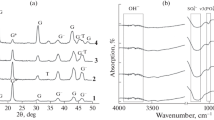Abstract
Calcium–aluminium–phosphate cements (CAPCs) for biomedical applications, mainly intended for applications in the dental field as non-resorbable fillers, were obtained by reacting Ca-aluminates compounds, i.e. CaO·Al2O3 (CA) and CaO·2 Al2O3 (CA2), with Al(H2PO4)3 aqueous solution. Hydroxyapatite was also introduced as a bioactive dispersed phase. Suitable elements like Sr and La were used to increase the radiopacity of the set yielded pastes towards X-ray wavelength used in clinical diagnostic radiographic equipments. La and Sr doped Ca-aluminates powders have been synthesized by solid state reaction at 1,400°C from a mixture of CaCO3, Al2O3, La2O3 and SrCO3. The characteristics of the obtained powders were analyzed and related to the starting compositions and synthesis procedures. The microstructure, setting time, radiopacity and compressive strength of the CAPCs have been investigated and discussed.









Similar content being viewed by others
References
Loof J, Engqvist H, Ahnfelt NO, Lindqvist K, Hermansson L. Mechanical properties of a permanent dental restorative material based on calcium aluminate. J Mater Sci: Mater Med. 2003;14:1033–7.
Sunnegårdh-Grönberg K, Peutzfeldt A, van Dijken JWV. Hardness and in vitro wear of a novel ceramic restorative cement. Eur J Oral Sci. 2002;110:175–8.
Engqvist H, Schultz-Walz J-E, Loof J, Botton GA, Mayer D, Phaneuf MW, Ahnfelt N-O, Hermansson L. Chemical and biological integration of a mouldable bioactive ceramic material capable of forming apatite in vivo in teeth. Biomaterials. 2004;25:2781–7.
Lööf J, Engqvist H, Hermansson L, Ahnfelt NO. Mechanical testing of chemically bonded bioactive ceramic materials. Key Eng Mater. 2004;254–256:51–4.
Axén N, Persson T, Björklund K, Engqvist H, Hermansson L. An injectable bone void filler cement based on Ca-aluminate. Key Eng Mater. 2004;254–256:2658.
Hermansson L, Lööf J, Jarmar T. Injectable ceramics as biomaterials—today and tomorrow. In: Bellosi A, Babini GN, editors. Global roadmap for ceramics—ICC2 Proceedings Verona; June 29–4, 2008. pp. 607–616.
Wagh AS, Jeong SY. Chemically bonded phosphate ceramics: I, a dissolution model of formation. J Am Ceram Soc. 2003;86:1838–44.
Werner J, Diedel R, Hölzel T, Blaurock M. Mixed cements in the system calcium–aluminium–phosphate for potential biomedical applications. In: Heinrich JG and Aneziris C, editors. Proceeding of the 10th ECerS Confonference. Göller Verlag, Baden-Baden: 2007. pp. 948–53.
Coomaraswamy KS, Lumley PJ, Shelton RM, Hofmann MP. Evaluation of different radiopacifiers for an MTA-like dental cement. Key Eng Mater. 2008;361–363:885–8.
Baroth S, Bourges X, Fellah B, Daculsi G. Radiopaque strategy for bone injectable substitute. Key Eng Mater. 2008;361–363:39–42.
Chan DCN, Titus HW, Chung K-H, Dixon H, Wellinghoff ST, Rawls HR. Radiopacity of tantalum oxide nanoparticle filled resins. Dental Mater. 1999;15:219–22.
Wang X, Ye J, Wang Y. Influence of a novel radiopacifier on the properties of an injectable calcium phosphate cement. Acta Biomater. 2007;3:757–63.
Bohner M, Gbureck U, Barralet JE. Technological issues for the development of more efficient calcium phosphate bone cements: a critical assessment. Biomaterials. 2005;26:6423–9.
Boyd D, Towler MR, Watts S, Hill RG, Wren AW, Clarkin OM. The role of Sr2+ on the structure and reactivity of SrO–CaO–ZnO–SiO2 ionomer glasses. J Mater Sci: Mater Med. 2008;19:953–7.
Kjellson F, Almen T, Tanner KE, McCarthy ID, Lidgren L. Bone cement X-ray contrast media: a clinically relevant method of measuring their efficacy. J Biomed Mater Res Part B: Appl Biomater. 2004;70B:354–61.
Nrrse RW, Welch JH, Majumdar AJ. System CaO–Al2O3 in a moisture-free atmosphere. Trans Brit Ceram Soc. 1965;64:416.
Li J, Hermansson L. High-strength aluminate cement produced by cold isostatic pressing. J Mater Sci. 2000;35:5879–83.
Chen DM, Fu YF. Evaluation on the mechanical properties of the solid solution of strontium substituted hydroxyapatite. Chin J Stoma Mater Appar. 2001;19:178–83.
Author information
Authors and Affiliations
Corresponding author
Rights and permissions
About this article
Cite this article
Medri, V., Mazzocchi, M. & Bellosi, A. Doped calcium–aluminium–phosphate cements for biomedical applications. J Mater Sci: Mater Med 22, 229–236 (2011). https://doi.org/10.1007/s10856-010-4205-3
Received:
Accepted:
Published:
Issue Date:
DOI: https://doi.org/10.1007/s10856-010-4205-3




